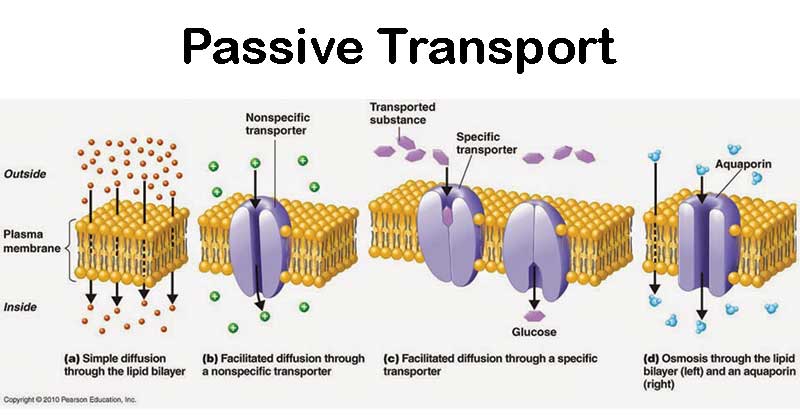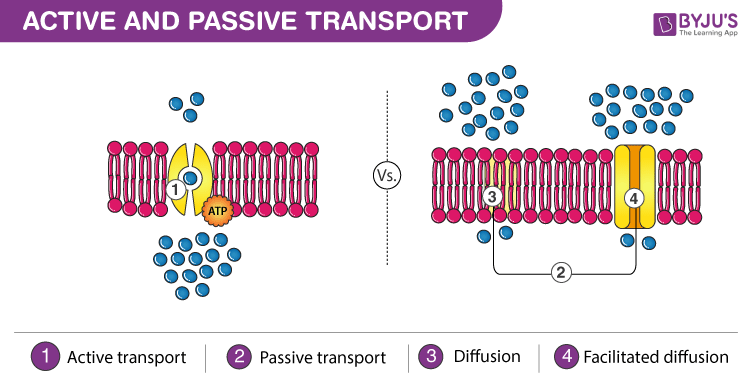Describe Passive Transport Across a Biological Membrane
Passive membrane transport does not use energy in the form of ATP to move substances across biological membranes. Passive transport is a naturally occurring phenomenon and does not require the cell to expend energy to accomplish the movement.
That doesnt mean however that no energy is used in the movement of ions across membranes.

. Intuitively you probably believe that the rate of net diffusion or the flux of A across the membrane is directly proportional to the concentration gradient across the membrane. It is the biological process of movements of the biochemical across the cell membranes and tissues. Passive transport occurs by simple diffusion or via pores in the plasma membrane Figure 32.
The most direct forms of membrane transport are passive. In this transport system molecules are transported from its higher concentration to the lower concentration until concentration gradient is diminished. The most direct forms of membrane transport are passive.
Passive transport is a naturally occurring phenomenon and does not require the cell to expend energy to accomplish the movement. Some cells function best at a pH. Passive transport also known as passive diffusion is a process by which an ion or molecule passes through a cell wall via a concentration gradient or from an area of high concentration to an area of low concentration.
In passive transport substances move from an area of higher concentration to an area of lower concentration in a process called diffusion. Passive transport is a naturally occurring phenomenon and does not require the cell to expend energy to accomplish the movement. Passive transport is the movement of molecules from an area of higher concentration to an area of lower concentration without the use of energy.
A solid rod of actin protein in the cytoplasm of almost all eukaryotic cells makes up part of the cytoplasm and acts alone or with myosin to cause cell contraction. In passive transport substances move from an area of higher concentration to an area of lower concentration. Type of transport that does not require energy to occur.
A physical space in which there is a. If concentrations of A are identical across the. The basic types of membrane transport simple passive diffusion facilitated diffusion by channels and carriers and active transport are summarized in Fig.
Passive transport is a type of transport across the cell membrane that does not require energy while active transport is the opposite. So it is a passive process. Diffusion is a process of passive transport in which molecules move from an area of higher concentration to.
The most direct forms of membrane transport are passive. Each protein transports a particular class of molecule such as ions sugars or amino acids and often only certain molecular species of the class. Passive transport refers to transport across the cell membrane that does not require energy from metabolic processesInstead this form of transport relies on the natural kinetic energy of molecules and their random movementThere are three modes of passive transport.
Membrane Transport - Passive Transport. Most lipophilic molecules cross membranes by simple diffusion in accord with Ficks first law of diffusion see equation below which states that the flux or rate at which a molecule diffuses across the plasma membrane is proportional to the concentration gradient the membrane. The diffusion of a substance across a biological membrane without.
Passive transport mechanism does not require cellular energy to transport molecules across cell membrane. The quality of a membrane that allows substances to pass through it. The most direct forms of membrane transport are passive.
Special membrane transport proteins are responsible for transferring such solutes across cell membranes. These proteins occur in many forms and in all types of biological membranes. In passive transport substances move from an area of higher concentration to an area of lower concentration in a process called diffusion.
In passive transport substances move from an area of higher concentration to an area of lower concentration in a process called diffusion. The most direct forms of membrane transport are passive. Only a few representative examples will be discussed here.
Passive transport is a naturally occurring phenomenon and does not require the cell to exert any of its energy to accomplish the movement. Its like moving from the train to the platform of a subway station or stepping out of a crowded room. Passive Transport Active transport.
There are at least four main types of passive transport which are important to cells because they move materials of small molecular weight across membranes. The state at which a substance is equally distributed throughout a space. It is the biological process of movement of the molecules against the concentration gradient.
Lets start with passive diffusion of uncharged solute A across a membrane which can be represented by the chemical equation A out A in. Osmosis is the movement of water across a membrane from an area of low solute concentration to an area of high. Transport Across Membranes Diffusion.
Passive Membrane Transport Review - Process Energy Source Example Simple diffusion Kinetic energy Movement of O2 through membrane Facilitated diffusion Kinetic energy Movement of glucose into cells Osmosis Kinetic energy Movement of H2O in out of cells Filtration Hydrostatic pressure Formation of kidney filtrate 60. The cell membrane is one of the great multi-taskers of biology. Passive transport is a naturally occurring phenomenon and does not require the cell to exert any of its energy to accomplish the movement.
A region of space over which the concentration of a substance changes. In passive transport substances move from an area of higher concentration to an area of lower concentration in a process called diffusion. In passive transport substances move from an area of higher concentration to an area of lower concentration.
There are countless different examples of each type of membrane transport process. Tonicity which is. Passive transport is a naturally occurring phenomenon and does not require the cell to expend energy to accomplish the movement.
Passive transport and active transport across a cell membrane article Transport Across a Cell Membrane. The most direct forms of membrane transport are passive.



No comments for "Describe Passive Transport Across a Biological Membrane"
Post a Comment